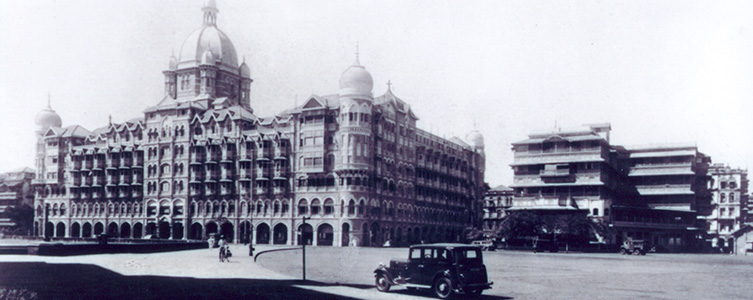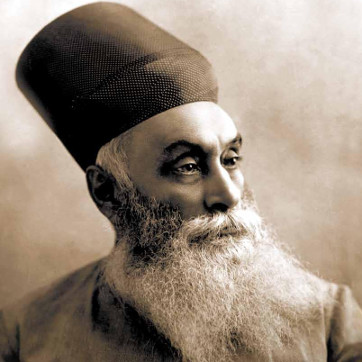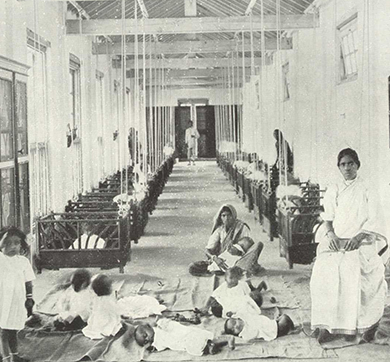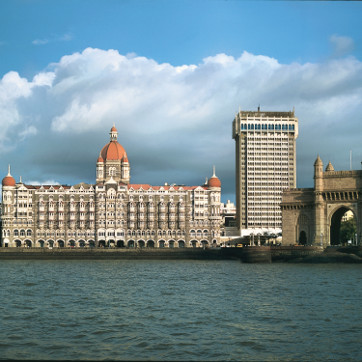1250 words | 5-minute read
Jamsetji Tata was more than an industrialist—he was a nationalist with a fervour to see India ranked among the great nations of the world. To this end, he passionately pursued his dreams for India, only one of which was truly complete in his lifetime—a hotel Bombay and the country could be proud of.
The founder chose a site facing the magnificent Arabian Sea, selected one of the world’s leading architects to design the hotel of his dreams, and equipped the Taj Mahal Palace with the best the world had to offer at the time.
A hotel to inspire pride
Jamsetji Tata spent more than £300,000 on the Taj Mahal hotel. A hundred years ago that was an enormous sum of money. But more than just money was the care and attention he lavished on it. His sons, his friends, his business associates — everyone urged him not to go ahead with the project. It’s going to lose money, they insisted. But Jamsetji was obdurate. “Perhaps it will,” he said, “but that makes no difference”. He wanted Indians to get what they needed — a great hotel that would be proud to serve them.

Under Jamsetji Tata’s watchful eye, the Taj rose on the seafront, an impressive edifice that dominated the landscape, predating Bombay’s Gateway of India.
When the Taj opened its doors in Bombay in 1903, it inspired delight and awe in every Indian, and not just for its imposing exterior. To many Indians who had never travelled abroad before, this Taj was an incredible wonder of the modern world, a tantalising glimpse into the future. The Taj was the first building in Bombay to be electrified. It had the first ice-making machine. The first soda maker. The first lift. The first generator. The first mechanised laundry. The first polishing machine. Most important of all, it was a hotel into which any Indian could walk with his head held high, confident that he would be treated with courtesy and respect.
One hundred years after it was opened, the Taj has retained its position as one of the world’s great hotels, often a destination in itself. Over the years, the hotel has been a witness to many historic events of local, national and international importance. The farewell speech of Lord Mountbatten, for instance, took place in the hotel’s ‘grand ballroom’ (he boarded his ship and left India after his speech here).

There is the ‘princes’ room’, where the royal princes met to discuss becoming a part of the new India. More recently the hotel has been the port of call for practically every important head of state. The Taj continues to have that cachet in the corporate world, too.
It has spun off an entire chain of hotels, the largest in India. Today, the Indian Hotels Company Ltd (IHCL) is a chain of over 100 luxury, business and resort hotels across 62 destinations worldwide. Each hotel built with the same careful attention. But more than bricks and mortar, it’s Indian courtesy that sets them apart.
Ultimately, as Jamsetji Tata well knew, this is really our finest Indian heritage.

Did you know?
- The foundation of the Taj Mahal, laid in 1898, is 40 feet deep. The hotel was built at a cost of more than Rs. 4 crore.
- It was the first building in Bombay to be lit by electricity, the first to have telephones in every room, electric elevators and an ice-making machine! It also was the first to have American fans, German elevators, Turkish baths and English butlers.
- At the time, a suite of rooms, including full board, cost the princely sum of Rs. 30.

- It preceded the famous Gateway of India by over 20 years. Until then the hotel was the first sight for ships calling at the Bombay port.
- The imposing edifice of the hotel is an amalgam of styles that range from Moorish domes to Oriental and Rajput architecture.
- An early report describes the horror of a receptionist looking up to see a monarch march in, followed by his pet tiger on a chain.

- Jamsetji Tata had visited the famous Paris exhibition at the turn of the century (for which the Eiffel Tower was built). He saw there, pillars of spun iron displayed for the first time, and ordered 10 to be shipped home for his new hotel. Today they seem indestructible as they continue to hold up the hotel's famous ballroom.
- Something written in 1905 is worth repeating. A Mr GA Mathews says about the Taj in his Diary Of An Indian Tour: "The Taj Hotel is on such a scale of magnificence and luxury that at first it rather took one's breath away. There is no other hotel in India which will bear comparison with it, as it is in a rank of its own."
- When it opened the Taj was perhaps the only place in the world where staunch Congressmen could debate with defenders of the British Empire, and where sailors on shore leave could flirt with Pompadour follies.
- During World War I (1914 to 1918), the hotel was converted into a 600-bed hospital.
- The Taj had Mumbai's first-ever licensed bar, the Harbour Bar (bar licence No 1), India's first all-day dining restaurant, and the country's first international discotheque, Blow Up.
- Mohammed Ali Jinnah (the originator of the idea of partition and, later, the first head of state of Pakistan) and Sarojini Naidu (president of the Indian National Congress), both held court in suites at the Taj.

- In 1947, independent India's first speech to industry was made at the hotel.
- In 1973, a tower wing was conceived with 23 storeys of arches and balconies, topped by a jagged diadem.
- In its centenary year, 2003, the Taj was rejuvenated. It has a new name — The Taj Mahal Palace and Towers — new restaurants, beautifully restored guest rooms and a charming new lobby lounge. Two venerated restaurants were reopened in new avatars: 'Masala Kraft' for the erstwhile Tanjore and 'The Souk', earlier the Apollo Bar.
Source: JN Tata Centenary Diary, Tata Steel, 2004 and 'An Icon and an Ideal', Tata Review



